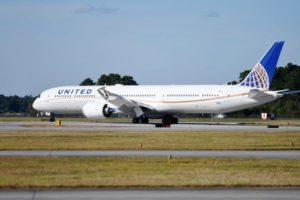Leeham News and Analysis
There's more to real news than a news release.
 Leeham News and Analysis
Leeham News and Analysis
- Bjorn’s Corner: New engine development. Part 4. Propulsive efficiency April 19, 2024
- Boeing unlikely to meet FAA’s 90-day deadline for new safety program April 18, 2024
- Focus on quality not slowing innovation, says GKN April 18, 2024
- Boeing defends 787, 777 against whistleblower charges April 17, 2024
- Dissecting Boeing CEO’s statement next new airplane will cost $50bn April 15, 2024
Impact of 787-10 HGW on the large twin-aisle aircraft market
Subscription Required
By Vincent Valery
Introduction
Feb. 14th, 2022, © Leeham News: Boeing Commercial Aircraft (BCA) CEO Stan Deal announced that the company was working on a high gross weight (HGW) variant of the 787-10 Dreamliner.
LNA later revealed that the maximum takeoff weight (MTOW) increase would also be available on the 787-9. The goal of the increased MTOW is to make the 787-10 more competitive against the A350-900, which currently has a significantly higher nominal range: 6,430 nm vs. 8,100 nm. The 787-10 HGW range should match that of the 777-200ER.
The 787-10 HGW targets replacing larger, older-generation, twin-aisle aircraft still in service, notably the 777-200ER and 777-300ER. Boeing's primary goal is to prevent customers from ordering the Airbus A350-900 due to a lack of payload-range for the 787-10.
Boeing paused developing the 777-8 around 2.5 years ago, and it is not clear whether the variant will ever enter service. Therefore, without the 787-10 HGW, there would be a sizable seat gap between the 787-9 (290) and 777-9 (414) in the American OEM's long-range twin-aisle offering. Both A350 variants are in that seat gap.
The arrival on the market of the 787-10 HGW has the potential to affect sales opportunities for the A350 and the 777X. LNA analyses the potential replacement market for long-range aircraft seating 300 or more passengers in this context.
Summary
- Large twin-aisle replacement market;
- 787-10 HGW potential customers;
- The airlines unlikely to order the 787-10 HGW.
To read the rest of the article Login or Subscribe today.
Email Subscription
Twitter Updates
My TweetsAssociations
Aviation News-Commercial
Commentaries
Companies-Defense
Resources
YouTube
Archives
- April 2024
- March 2024
- February 2024
- January 2024
- December 2023
- November 2023
- October 2023
- September 2023
- August 2023
- July 2023
- June 2023
- May 2023
- April 2023
- March 2023
- February 2023
- January 2023
- December 2022
- November 2022
- October 2022
- September 2022
- August 2022
- July 2022
- June 2022
- May 2022
- April 2022
- March 2022
- February 2022
- January 2022
- December 2021
- November 2021
- October 2021
- September 2021
- August 2021
- July 2021
- June 2021
- May 2021
- April 2021
- March 2021
- February 2021
- January 2021
- December 2020
- November 2020
- October 2020
- September 2020
- August 2020
- July 2020
- June 2020
- May 2020
- April 2020
- March 2020
- February 2020
- January 2020
- December 2019
- November 2019
- October 2019
- September 2019
- August 2019
- July 2019
- June 2019
- May 2019
- April 2019
- March 2019
- February 2019
- January 2019
- December 2018
- November 2018
- October 2018
- September 2018
- August 2018
- July 2018
- June 2018
- May 2018
- April 2018
- March 2018
- February 2018
- January 2018
- December 2017
- November 2017
- October 2017
- September 2017
- August 2017
- July 2017
- June 2017
- May 2017
- April 2017
- March 2017
- February 2017
- January 2017
- December 2016
- November 2016
- October 2016
- September 2016
- August 2016
- July 2016
- June 2016
- May 2016
- April 2016
- March 2016
- February 2016
- January 2016
- December 2015
- November 2015
- October 2015
- September 2015
- August 2015
- July 2015
- June 2015
- May 2015
- April 2015
- March 2015
- February 2015
- January 2015
- December 2014
- November 2014
- October 2014
- September 2014
- August 2014
- July 2014
- June 2014
- May 2014
- April 2014
- March 2014
- February 2014
- January 2014
- December 2013
- November 2013
- October 2013
- September 2013
- August 2013
- July 2013
- June 2013
- May 2013
- April 2013
- March 2013
- February 2013
- January 2013
- December 2012
- November 2012
- October 2012
- September 2012
- August 2012
- July 2012
- June 2012
- May 2012
- April 2012
- March 2012
- February 2012
- January 2012
- December 2011
- November 2011
- October 2011
- September 2011
- August 2011
- July 2011
- June 2011
- May 2011
- April 2011
- March 2011
- February 2011
- January 2011
- December 2010
- November 2010
- October 2010
- September 2010
- August 2010
- July 2010
- June 2010
- May 2010
- April 2010
- March 2010
- February 2010
- January 2010
- December 2009
- November 2009
- October 2009
- September 2009
- August 2009
- July 2009
- June 2009
- May 2009
- April 2009
- March 2009
- February 2009
- January 2009
- December 2008
- November 2008
- October 2008
- September 2008
- August 2008
- July 2008
- June 2008
- May 2008
- April 2008
- March 2008
- February 2008


